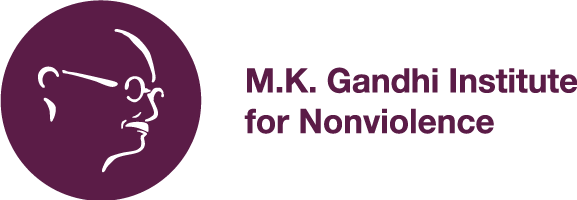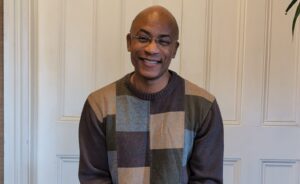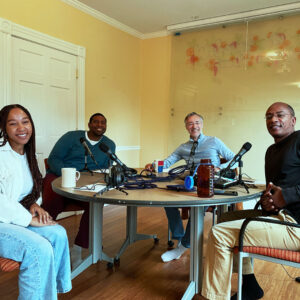This past September, more than thirty years after finishing my undergraduate degree, I entered a graduate program on Social Innovation and Sustainability at Goddard College in Vermont. The focus of my studies arose from the work I have the privilege of doing at the MK Gandhi Institute for Nonviolence, particularly in relation to addressing issues of alienation and sorrow that so many people of all ages report.
Specifically I am interested in:
- how to support people (myself included) to acquire a new set of lens on the world that includes an understanding of systems thinking, which feels critical for responding to and resolving many human challenges;
- understanding grief, and creating avenues for sharing unexpressed sorrow and loss that appears to be pervasive in people of all ages, blocking us from loving our lives and from recognizing our power to make the world a better place.
What follows is a description of two efforts to support communal grief work. The first was with a class studying the apocalypse as a theme in US culture at the University of Rochester and the second was a public event called a grief cafe. These two projects represented approximately forty hours of effort.
Learning from the Haudenosaunee
Dr. Leila Nadir is a professor at the University of Rochester in the Environmental Humanities Program. We met in August in the garden at the Gandhi Institute, to speak about her fall 2017 class on the theme of apocalypse in US culture and media. Remembering the emotional hardships of my undergraduate days, when issues of nuclear weapons and annihilation were discussed without any acknowledgement for the emotional impact, I asked Leila if she planned to help her students process any of the emotions that this content would stimulate. She had not and this led to our collaboration. She applied for and received a small grant to bring her class to Syracuse NY to the Skä•noñh – Great Law of Peace Center. Our plan was two fold: for students to learn about the Haudenosaunee people and their two brushes with near-apocalypse, and for them to experience a communal grief ritual.
The Haudenosaunee, commonly called the name Iroquois given by French explorers, have occupied the lands of what is now New York State for centuries. According to Haudenosaunee written histories, the first near apocalypse of the people over one thousand years ago was the result of an epidemic of warfare, violence, and even cannibalism. The coming of the person now known as the Peacemaker who helped to establish the Five Nations of the Iroquois, was in response to this crisis. The second near-apocalypse was a result of the policies of the English, French and then American governments, particularly the Sullivan campaign in 1779 when American troops destroyed forty Iroquois villages just after the fall harvests. In addition to killing men, women and children, all food was destroyed in hopes of starving those left alive.
The values that emerged from and sustained the Iroquois people through these events, these twin potential apocalypses, are highlighted at the Skä•noñh – Great Law of Peace Center primarily through art and through more than a dozen brief videos featuring interviews with living Haudanosaunee elders who reflect on the values and traditions.
On Sunday, November 12 I spent the day at Skä•noñh with Dr. Nadir and thirteen students, led by Jack Manno and Cindy Squillace. Both Jack and Cindy were deeply involved with the founding of the center as allies of the Onondaga people and have served as guides for white people to Haudanosaunee culture on many occasions. Cindy, who is a grief counselor, led the grief ritual. Afterward, we were joined by one of the elders featured in the exhibits, Freida Jacques, clan mother of the Onondaga Nation. The day was designed to educate the students about some of the events named above and to highlight values and practices that sustain Haudenosaunee people to this day. Below are three student reflections from the experience:
“Learning more about Haudanosaunee culture and storytelling made me think about some of the stories we tell ourselves to make sense of what is happening to us and the world around us. The story of the Peacemaker establishing peace without a war particularly struck me; all the previous narratives I had heard, of establishing order, had been preceded by defeating (usually killing) evil. And I guess that was still true in a sense; in a way, the power that evil had over Tadodaho was taken away, but was replaced with a sense of peace and belonging in a way that included him in the peacemaking. It showed that people can change if we have enough emotional reserves in ourselves to let them, and that the capitalist idea of people having their ‘preordained positions’ …is complete nonsense.”
“I was surprised at how moving I found this trip to be. As someone coming in with little knowledge of Haudenosaunee culture, I did expect the trip to be informative, but I didn’t see it acting as a point of such deep reflection….I think I am not alone in getting alot out of the grief circle we took part in. I am really grateful that we were able to do that together, and I found it really therapeutic.”
“The workshop on grieving had a very strong impact on me. Over the past few years, I have been spending an increasing amount of time trying to identify and change some of the behavioral characteristics that I had internalized because of the way in which I was raised, and I often felt isolated from my peers. I felt some of that loneliness disappear as people stepped forward to share their own losses and express their own grief at what they had been through. In listening to others share their memories of heartbreak, I felt empowered and more able to express my own pain without worrying about being invalidated or shut down. I also left feeling angry at the idea that we must live our lives in a practical way; so many people go through life without having an outlet for talking about their feelings or allowing themselves to heal from some of the pain that they experienced, simply because of this one assumption. It was an incredible experience for me, and I felt lucky to have been a part of it.”
The Grief Cafe
Last summer, I ran across the phrase ‘grief cafe’. I liked the phrase as I have heard people express fear of grief rituals and ceremonies, and I wondered if calling it a ‘cafe’ would support interest and curiosity instead. I invited members from my women and race group, Shades of Sisterhood, and my colleagues at the Gandhi Institute to co-facilitate. At the end, two women from my group and one woman from staff met with me to plan the first two hour event, which took place December 2.
Drawing on wisdom from Francis Weller’s book The Wild Edge of Sorrow as well as our collective past experience, we designed the event to include a welcome, gentle physical movement and meditation, creative exercises, a talking circle and a closing ritual. The four facilitators decided which pieces they chose to lead and each spoke briefly about their own journey and experience with grief. Six participants attended the event, which was marketed by and hosted at the Gandhi Institute where I work. With the four facilitators, there were 10 of us in total. All of us participated
After the welcoming circle, we invited silence for the twenty minutes of physical movement and meditation. Silence continued as people spent thirty minutes in a creative exploration of self-connection, through using provided journals for writing or through drawing and art materials, which were also provided. One participant elected to simply meditate in lieu of the creative exercise in the meditation space at the Institute. Hot tea was available in the nearby kitchen. Food was not provided, given the challenges many have with food as an emotional crutch.
During the 45 minute talking circle, participants were asked to share what felt true in the moment about their choice to attend and what arose during the quiet of the movement, meditation or creative periods. One man said he didn’t experience grief and hadn’t cried in years. The only emotion he routinely notices is anger. Other participants shared stories of loss, grief and resilience. Two cried. Another person shared his self-portrait, noticing that in the midst of unacknowledged sorry he drew himself without hands or feet. He commented, “I have no feet to leave and no hands to help”. After the talking circle, we concluded a closing ritual drawn directly from Weller’s book (p. 163), called the stone ritual.
Acknowledging that this event was an experiment, we asked participants to complete a written evaluation at the conclusion. On a scale of 1-10, the average of the forms received back was 9.
Closing Reflection
Gandhi and King both spoke about suffering as a redemptive opportunity. Father Richard Rohr speaks of love and suffering as the two great paths to transformation. I would like to learn how to support people to turn the straw in their lives into gold, to take the loneliness and fear that we carry in our separate selves and bring them into the potential for fellowship and systemic change that can occur when we share our deep pain in community.
Interested in attending or helping to create a grief café in your school, neighborhood or community? Email kit@gandhiinstitute.org and we’ll make it happen.




